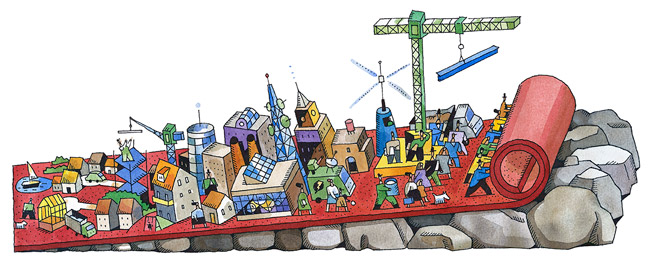For most entrepreneurs, structure is a four-letter word. They fight it because they love flying by the seat of their pants. Implementing systems and procedures feels like a constraint — something that’s going to crush creativity and spontaneity.
Yet when entrepreneurs move beyond startup into second stage, spontaneity can hinder their growth or even cause them to fail. Second-stagers have already achieved a certain level of success and want to scale the business. This means creating a more stable environment for employees instead of one where everyone feels like their hair is on fire or they’re starting from scratch every day. Structure helps you make desired behavior clear to employees — and enables your employees replicate that desired behavior.
Creating structure encompasses a wide range of activities, from simple HR policies to building a management team and to sophisticated technology systems. One of the easiest ways to think about structure is to view it as an antidote to a specific problem. What you implement all depends on where your pain points are.

Link information to motivation
Many second-stagers begin to warm up to structure and establish their first policies and procedures because of communication issues.
Take Larry Kooiker, founder of Agritek Industries, a manufacturer of engineered metal components in Holland, Michigan. Today he has more than 100 employees and the company has $17 million in annual revenue. Kooiker launched Agritek in 1987, and for many years he avoided structure because he associated it with waste, inefficiency, and moving slowly.
“Entrepreneurs don’t need to hold a committee meeting to get something done,” Kooiker says. “We don’t have to go through a formal process to identify a problem and determine the best solution. We just do it.”
As your company grows, people become disengaged
Yet in the late 1990s, when Agritek’s workforce grew beyond 20 employees, Kooiker realized his employees were more concerned about wrapping up their shifts rather than trying to produce parts faster or increase quality. Kooiker chalked up this attitude to a lack of communications. “When you only have a few employees, it’s easy for everyone to be excited and motivated,” he says. “They know what needs to be done because you’re working with them on a daily basis — it’s like they’re an extension of your right arm. Yet once you go over 20 employees, you lose that direct contact, and it’s easier for people become disengaged.”
In response, Kooiker began to create employee manuals, production goals, and documentation for operating equipment correctly (including details such as shut height, tonnage and adjustment). He also began holding quarterly companywide meetings to discuss how employees’ jobs aligned with the company’s mission and goals.
“In my world, the marketplace is trying to find the lowest-cost producer,” Kooiker says. “It’s a daunting task to produce a part profitably when all your competitors have said, ‘No, we can’t do it for that price.’ That’s what I have to get across to employees. They think this place functions just because we’re here. It’s eye opening for them when they realize the company only functions because we’re better, faster, cheaper and more innovative. Then they realize that’s the program they need to get on.”
Other early structure at Agritek revolved around systems for ordering parts, scheduling production, and quoting prices. “When you’re a small company, you can sketch a component design on a napkin and tell the customer you’ll make the part for $50,” Kooiker points out. “But as you grow larger, you need formal systems for pricing, specs and payment terms.”
There’s no one-size-fits-all
Thinking about structure is tricky. Although there are best practices to guide you, there are no cookie-cutter recipes. What kind of structure you implement all depends on what kind of organization you’re trying to create — and your business-level strategy.
If you’re competing on price, like Kooiker, then you want to implement policies, procedures, and systems to increase efficiency, control waste, and decrease costs. On the other hand, if your strategy is about product differentiation, your structure should be focused on promoting creativity and innovation.
Avoid these common mistakes:
- Being impatient. Structure is no quick fix. Whether you’re creating a policy, procedure, or system, view it as an experiment. Put it in place, and then assess the results. As you system meets reality, you may need to tweak it — or throw it out completely and try something else.
- Inconsistent implementation. Once you have something that works, make sure it’s used consistently throughout your organization. Be careful — employees may drift back to an old method or previous status quo.
- Going overboard. Too much structure can be just as dangerous as not enough. Policies and procedures should not feel like a prison and reduce your employees’ ability to think. Strive for balance and be open to employee innovation.
- Not looking back — or ahead. Periodically review policies and systems, and adjust them as your company grows. Ask yourself whether your structure still achieves what you need it to. Think about what your organization needs to look like in five years. Will your structure help you achieve that architecture?
The benefits outweigh the time and costs involved
Kookier couldn’t agree more. Even though he says the idea of structure is still distasteful, the reality of it has led to efficiencies and economies of scale that he likes very much. For example, today Agritek can purchase supplies in larger volume, run multiple shifts, and operate machines around the clock. “When we were smaller, we might only order $500 worth of steel,” Kooiker points out. “Today, we can put in a $50,000 order with no more effort — and get a better price. Then when that steel is delivered, we have overhead hoists that unload it in the same time it once took to unload a $500 order from a pickup truck.”
Indeed, far from being a constraint, when done correctly, structure is actually liberating.
Structure is like a well-written software code that enables your organization to reduce errors and run consistently. It provides a platform for CEOs to be strategic and work on the business instead of in it. Structure is how second-stage leaders replicate themselves, build high-performing teams, expand market share, and hone their competitive edge.
Originally published Nov. 7, 2013, on Inc.com (http://www.inc.com/dino-signore/why-growth-entrepreneurs-need-structure.html)
